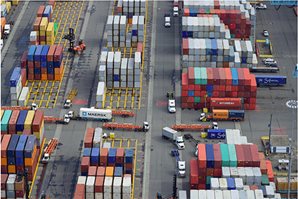 The port serving New Jersey and New York continues its strong growth, driven by new consumer spending patterns and prompting new hiring and redevelopment plans in the City of Newark. Members of the NJTPA Freight Initiatives Committee heard about the growth and its impacts at their April 18 meeting.
The port serving New Jersey and New York continues its strong growth, driven by new consumer spending patterns and prompting new hiring and redevelopment plans in the City of Newark. Members of the NJTPA Freight Initiatives Committee heard about the growth and its impacts at their April 18 meeting.
Committee Chair Jason Sarnoski, Warren County Commissioner, introduced speakers for the annual port and maritime update, noting that the port is a “leading economic engine for the region and the nation.”
Sam Ruda, Director of the Port Authority of New York and New Jersey’s Port Department, said container traffic at the port is 8 to 10 percent above the record levels seen in 2021 and continues to grow. The growth, he said, was driven by “a massive change in personal consumption” favoring goods over services, a trend that accelerated as people ordered online during the pandemic.
At the same time, he said, shippers facing congestion, backlogs and labor issues at West Coast ports are shifting an increasing share of commerce to New York-New Jersey and other, smaller East Coast ports.
As a result, he said, “terminals are operating at full or near full capacity,” running ahead of planned-for levels by six or seven years. At the same time the port faces shortages of truck drivers and chassis and other constraints requiring “complex fixes.” Improvements will be needed to sustain this growth, such as deepening channels from 50 to 55 feet, he said.
The growth has spurred a strong demand for workers, according to John Nardi, President of the New York Shipping Association. The port employs over 3,500 longshoremen and other workers. They were deemed essential workers early in the pandemic, and operations were disrupted as hundreds of workers were idled by the virus, despite efforts to put in place protections.
As operations continued under pandemic-related challenges, Nardi said the port faced a “tidal wave of freight,” requiring the hiring of more workers. But he notes the Port of New York and New Jersey requires thorough background checks before workers can be hired. That check is conducted by the Waterfront Commission, which was jointly established by New York and New Jersey to combat port corruption in the 1950s. Once workers gain experience, they often can earn $150,000 or more a year, he said.
In addition to 581 workers hired from 2018 to mid-2020, the Shipping Association got Commission approval last August to hire 200 additional workers and just initiated requests for nearly 300 more. In addition to helping meet growing freight demand, the hires help replace retiring workers. Due to the nature of work and conditions on the docks, he notes, “it’s a young person’s job.”
The State of New Jersey, he said, is seeking to withdraw from the Waterfront Commission and turn its functions over to the State Police which would speed the hiring process. However, New York is bringing a case challenging the withdrawal to the Supreme Court, which he said presents “interesting” legal issues about bi-state compacts.
Meanwhile, his association is cooperating with the Council on Port Performance to conduct outreach to potential workers and communities in Newark, Elizabeth and surrounding areas.
Facilitating access to port jobs is one of the motivations for a new redevelopment effort, called Forward-Bound Doremus, in the City of Newark, according to Christopher A. Watson, the City’s Planning Officer.
Watson said the effort focuses on five districts adjacent to Doremus Avenue, which runs from the port to industrial and warehousing areas along the Passaic River. The districts include residential areas in the Ironbound.
Among the objectives of the project are to make the corridor a primary employment center for the community, create comprehensive regulations governing development, promote environmental justice and resiliency and strengthen transportation connections for people and goods.
He noted that 9 percent of jobs in Newark are in this area, some of them among the highest paying in the City. However, he said, area residents need better access to the jobs, including programs to close the “skills gap” that hampers their employment.
He said the project seeks to cultivate a “reciprocal relationship” that would link port businesses to local neighborhoods and nearby commercial activities. At the same time, the redevelopment efforts would attract new port-related businesses, including distribution facilities engaged in last-mile deliveries for e-commerce.
Redevelopment, he said, must help address environmental concerns, including flooding in the area. This could include “green” approaches such as permeable pavements for parking lots and using parks to mitigate flood impacts. An assessment of needed changes to zoning and other regulations will help realize these and other objectives, he said.
A recording of the presentations at the Freight Initiatives Committee meeting is here.